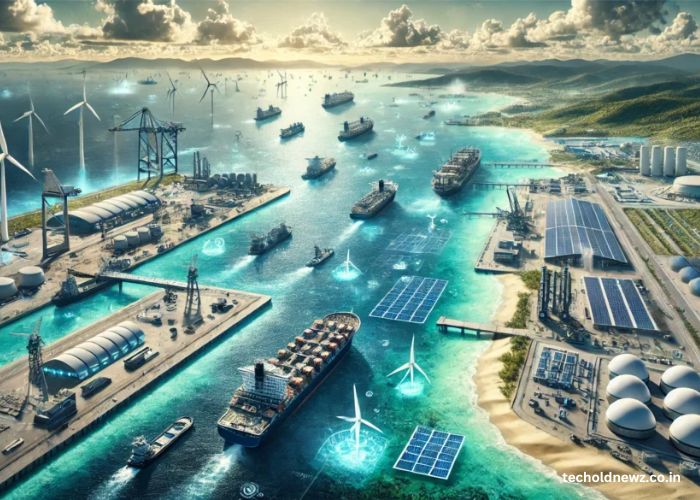The maritime technologies complex refers to a network of advanced systems, tools, and innovations developed to enhance maritime operations. This complex plays a crucial role in shipbuilding, ocean exploration, naval defense, and sustainable marine practices. With growing global trade and environmental concerns, maritime technology has evolved into a multifaceted industry.
Key Points:
- Maritime technologies complex enhances global shipping efficiency.
- It integrates sustainability, safety, and cutting-edge innovation.
- It is vital for naval defense and marine exploration.
What Is the Maritime Technologies Complex?
The maritime technologies complex is an umbrella term that covers diverse technologies, including shipbuilding, navigation systems, underwater robotics, and ocean energy solutions. These technologies collectively enable safer, more efficient, and sustainable use of marine resources.
For instance, navigation systems like GPS and radar enhance the safety of sea routes, while underwater drones assist in deep-sea exploration. By incorporating artificial intelligence (AI), these systems are becoming smarter and more autonomous. The maritime industry also focuses on reducing carbon footprints by using eco-friendly technologies like hydrogen-powered vessels and solar energy integration.
Note: The maritime technologies complex is crucial in addressing climate change and ocean conservation challenges.
How Does the Maritime Technologies Complex Impact Global Trade?
Maritime technology has a profound impact on global trade, as over 80% of the world’s trade by volume is carried by sea. Advanced shipping solutions, such as smart ports and automated cargo handling, have streamlined operations.
Table: Comparison of Traditional vs. Modern Maritime Operations
| Aspect | Traditional Maritime Operations | Modern Maritime Operations |
|---|---|---|
| Navigation | Manual maps and compasses | GPS, radar, and AI-powered tools |
| Energy Source | Fossil fuels | Renewable sources (e.g., hydrogen) |
| Cargo Handling | Manual labor-intensive | Automated systems and robotics |
| Environmental Impact | High pollution | Low-emission technologies |
Modern systems reduce delays, minimize errors, and cut costs. Smart ports, for instance, use data analytics to manage container traffic efficiently. The incorporation of blockchain technology ensures transparency and security in trade documentation.
Reminder: Efficient maritime technologies are vital for maintaining global trade connectivity.
What Are the Applications of Maritime Technologies?
Maritime technologies serve a wide range of applications:
Shipbuilding and Design
Advanced materials, such as lightweight composites, are being used to construct stronger and more efficient ships. These materials reduce fuel consumption and improve durability. Automated shipbuilding processes, guided by AI and robotics, enhance precision and reduce production time.
For example, 3D printing is revolutionizing ship component manufacturing, making repairs faster and more cost-effective. This innovation is particularly useful for naval and commercial shipping industries.
Ocean Exploration
Underwater exploration technologies, like remotely operated vehicles (ROVs) and autonomous underwater vehicles (AUVs), are transforming marine research. These devices can reach extreme depths, providing data on marine biodiversity and geological structures.
Ocean exploration also contributes to discovering new energy resources, such as undersea oil and gas reserves. With advancements in sensors and cameras, ROVs are becoming indispensable tools for oceanographers.
Naval Defense
Maritime technologies play a critical role in strengthening naval defense systems. Advanced sonar systems, surveillance drones, and missile defense technologies ensure the safety of maritime borders.
For example, stealth ships are designed to evade radar detection, enhancing their strategic advantage. AI-driven algorithms are also used to predict and counter potential threats in real-time.
Reminder: Investments in maritime defense technologies are essential for national security.
Sustainable Marine Practices
Sustainability is a key focus of the maritime technologies complex. Innovations like ballast water treatment systems, waste management solutions, and alternative fuels help reduce the environmental impact of shipping.
Table: Examples of Sustainable Maritime Technologies
| Technology | Description |
|---|---|
| Ballast Water Treatment | Prevents invasive species from spreading |
| Hydrogen-Powered Vessels | Reduces greenhouse gas emissions |
| Solar-Powered Ships | Utilizes renewable energy for propulsion |
| Carbon Capture Systems | Captures emissions to reduce environmental impact |
These sustainable practices align with global initiatives like the International Maritime Organization’s (IMO) strategy to cut emissions by 50% by 2050.
What Are the Challenges Facing the Maritime Technologies Complex?
Despite its advancements, the maritime technologies complex faces several challenges:
- High Costs: Developing and implementing advanced technologies require significant investments. Smaller shipping companies may struggle to afford these innovations.
- Regulatory Barriers: Compliance with international regulations can be complex, especially for new technologies like autonomous ships.
- Environmental Risks: While the industry aims to be sustainable, the disposal of old ships and equipment remains an issue.
- Cybersecurity Threats: As maritime operations become more digital, they are vulnerable to cyber-attacks. Ensuring robust security systems is crucial to protect sensitive data.
Conclusion
The maritime technologies complex is a dynamic and transformative field that influences global trade, national security, and ocean sustainability. From autonomous ships to sustainable marine practices, these technologies promise a future of innovation and environmental responsibility. By addressing challenges and embracing advancements, the maritime industry can continue to thrive while safeguarding our oceans.
FAQs
- What is the maritime technologies complex?
- It is a collection of advanced systems and innovations used to enhance maritime operations, including shipbuilding, navigation, and ocean exploration.
- Why is the maritime technologies complex important?
- It ensures efficient global trade, strengthens naval defense, and promotes sustainable use of marine resources.
- What are examples of maritime technologies?
- Examples include GPS navigation, autonomous ships, underwater drones, and hydrogen-powered vessels.
- How do maritime technologies support sustainability?
- They include solutions like ballast water treatment, alternative fuels, and carbon capture systems to reduce environmental impact.
- What challenges does the maritime technologies complex face?
- Key challenges include high costs, regulatory barriers, environmental risks, and cybersecurity threats.


